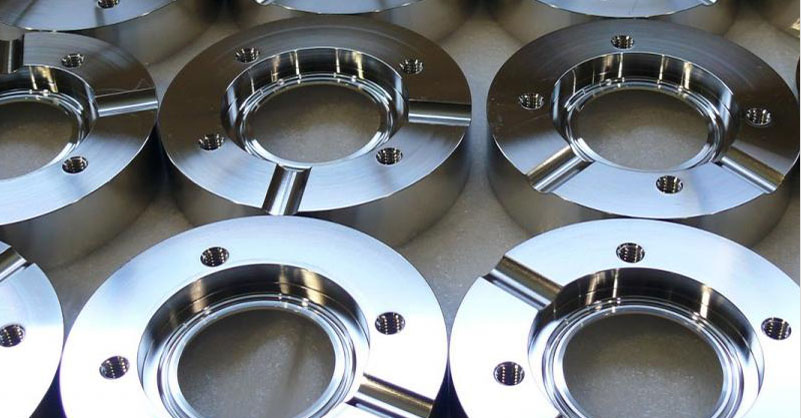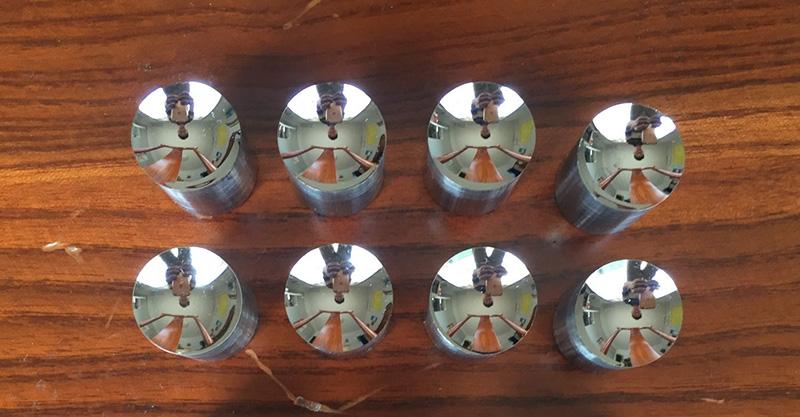With superb polishing technology, a SUS304 part becomes a dazzling mirror in a few minutes.
Polishing of precision parts usually uses whetstone strips, wool wheels, sandpaper, etc., to plastically deform the surface of the material and remove the protrusions on the surface of the workpiece to obtain a smooth surface. Manual operation is generally the main method. The ultra-finishing polishing method can be used for high surface quality requirements. The ultra-finishing polishing uses a special abrasive tool, which is pressed against the processed surface of the workpiece in a polishing fluid containing abrasives for high-speed rotation. Polishing can reach a surface roughness of Ra0.008 μm.
Commonly Used Tools And Specifications For Polishing
1) The commonly used tools for mold polishing are: sandpaper, whetstone, tape felt wheel, abrasive paste, alloy file, diamond sharpening needle, bamboo chip, fiber whetstone, and circular rotary grinder.
2) Sandpaper: 150#, 180#, 320#, 400#, 600#, 800#, 1000#, 1200#, 1500#
3) Whetstone: 120#, 220#, 400#, 600#
4) Tape felt wheel: cylindrical, conical, square tip
5) Grinding paste: 1# white, 3# yellow, 6# orange, 9# green, 15# blue, 25# brown, 35# red, 60# purple
6) File: square, round, flat, triangle and other shapes
7) Diamond grinding needles: generally 3/32 handles or 1/8 handles, with round wave shape, cylindrical shape, long straight cylindrical shape, and long circular cone shape.
8) Bamboo: Various shapes are suitable for the operator and the shape of the mold. The function is to press the sandpaper and grind on the workpiece to achieve the required surface roughness.
9) Fiber Whetstone: 200# black, 400# blue, 600# white, 800# red

Polishing Process
(1) Rough Polishing
The surface after finishing milling, EDM, grinding, etc. can be polished by a rotating surface polishing machine with a speed of 35000-40000r/min. Then there is manual whetstone grinding, and the strip whetstone is added with kerosene as a lubricant or coolant. The order of use is:
180#→240#→320#→400#→600#→800#→1000#.
(2) Semi-Precision Polishing
Semi-precision polishing mainly uses sandpaper and kerosene. The numbers of sandpaper are as follows:
400#→600#→800#→1000#→1200#→1500#.
In fact, #1500 sandpaper only uses die steel suitable for hardening (above 52HRC), not pre-hardened steel, because this may cause damage to the surface of pre-hardened steel parts and fail to achieve the expected polishing effect.
(3) Fine Polishing
Diamond polishing paste is mainly used for fine polishing. If the polishing cloth wheel is mixed with diamond grinding powder or grinding paste for grinding, the usual grinding sequence is:
9μm(1800#)→6μm(3000#)→3μm(8000#)
9μm diamond abrasive paste and polishing cloth wheel can be used to remove the hair-like wear marks left by the 1 200# and 150 0# sandpaper. Then use sticky felt and diamond abrasive paste for polishing, the sequence is:
1μm(14000#)→1/2μm(60000#)→1/4μm(100000#)
(4) Polished Working Environment
The polishing process should be done separately in two working locations, that is, the rough grinding processing location and the fine polishing processing location are separated, and attention should be paid to cleaning the sand particles remaining on the surface of the workpiece in the previous process.
Generally, after finishing rough polishing with whetstone to 1200# sandpaper, the workpiece needs to be transferred to a dust-free room for polishing to ensure that no dust particles in the air stick to the surface of the mold. The polishing process with accuracy requirements above 1μm (including 1μm) can be carried out in a clean polishing room. For more precise polishing, it must be in an absolutely clean space, because dust, smoke, dandruff and saliva may scrap the high-precision polished surface.
After the polishing process is completed, the surface of the workpiece must be protected from dust. When the polishing process is stopped, all abrasives and lubricants should be carefully removed to ensure that the surface of the workpiece is clean, and then a layer of mold anti-rust coating should be sprayed on the surface of the workpiece.
Factors Affecting Surface Polishing
(1) Surface Condition Of The Workpiece
During the machining process of the material, the surface layer will be damaged due to heat, internal stress or other factors, and improper cutting parameters will affect the polishing effect. The surface after EDM is more difficult to grind than the surface after machining or heat treatment. Therefore, it should be finished with EDM before the end of EDM, otherwise the surface will form a hardened thin layer. If the EDM fine-tuning rules are not selected properly, the depth of the heat-affected layer can reach up to 0.4mm. The hardness of the hardened thin layer is higher than that of the substrate and must be removed. Therefore, it is best to add a rough grinding process to provide a good foundation for polishing.
(2) The Steel Quality
High-quality steel is a prerequisite for good polishing quality, and various inclusions and pores in the steel will affect the polishing effect. To achieve a good polishing effect, the workpiece must be marked with the polished surface roughness at the beginning of machining. When a workpiece is determined to require mirror polishing, it must be a steel with good polishing properties and have been heat-treated, otherwise it will not meet the expectations. Effect.
(3) Heat Treatment Process
If the heat treatment is improper, the surface hardness of the steel is uneven or the characteristics are different, which will cause difficulty in polishing.
(4) Polishing Technology
Since polishing is mainly done manually, human skills are still the main reason that affects polishing quality.
It is generally believed that the polishing technology affects the surface roughness. In fact, a good polishing technology must be matched with high-quality steel and the correct heat treatment process to obtain a satisfactory polishing effect. On the contrary, if the polishing technology is not good, no mirror effect can be achieved even if the steel is good.

How To Solve Common Problems In Polishing
(1) Excessive Polishing
The biggest problem encountered in the daily polishing process is “over-polishing”, which means that the longer the polishing time, the worse the quality of the mold surface. There are two phenomena of over-polishing: “orange peel” and “pitting”. Excessive polishing occurs mostly in mechanical polishing.
(2) Reasons For “Orange Peel” On The Workpiece
The irregular and rough surface is called “orange peel”. There are many reasons for “orange peel”. The most common reason is that the mold surface is overheated or carburized. The polishing pressure is too large and the polishing time is too long. The main reason for “orange peel”. For example: polishing with a polishing wheel, the heat generated by the polishing wheel can easily cause “orange peel”. Harder steel can withstand higher polishing pressure, and relatively soft steel is prone to over-polishing. Studies have shown that the time for over-polishing will vary depending on the hardness of the steel.
(3) Measures To Eliminate “Orange Peel” Of Artifacts
When the surface quality is found to be poorly polished, many people will increase the polishing pressure and prolong the polishing time. This practice often makes the surface quality worse.
The following methods can be used to remedy:
1) Remove the defective surface, and the grit size is slightly coarser than the previous sand size, and then the grinding is carried out, and the polishing force is lower than the previous one.
2) Perform stress relief at a temperature of 25 ℃ lower than the tempering temperature. Use the finest sand number to grind before polishing until a satisfactory result is achieved, and finally perform polishing with a lighter force.
(4) Causes Of “Pitting” On The Surface Of The Workpiece
Because there are some non-metallic impurities in the steel, which are usually hard and brittle oxides, they are pulled out from the surface of the steel during the polishing process to form pits or pitting corrosion. The main factors that produce “pitting corrosion” are as follows:
1) The polishing pressure is too high and the polishing time is too long.
2) The purity of steel is not enough, and the content of hard impurities is high.
3) Rust on the mold surface.
4) The black leather is not removed.
(5) Measures To Eliminate Pitting Corrosion Of Workpieces
1) Carefully re-grind the surface. The sand grain size is one level coarser than the previously used grain size. Use soft and sharp whetstone for the final step of grinding before proceeding to the polishing process.
2) When the size of sand particles is less than 1 mm, avoid using the softest polishing tool.
3) Use the shortest polishing time and the smallest polishing strength possible.


